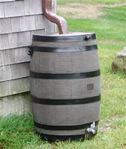Radnor, PA
Home MenuSolutions to Stormwater Pollution
As stormwater flows over driveways, lawns, and sidewalks, it picks up debris, chemicals, dirt, and other pollutants. Stormwater then flows into a storm sewer system or directly to a lake, stream, river, wetland, or coastal water. Anything that enters our storm sewer system is discharged untreated into the waterbodies we use for swimming, fishing, and providing drinking water. It does not go to the water treatment facility. Polluted runoff is the nation’s greatest threat to clean water. By practicing healthy household habits, homeowners can keep common pollutants like pesticides, pet waste, grass clippings, and automotive fluids off the ground and out of stormwater. Adopt these healthy household habits and help protect lakes, streams, rivers, wetlands, and coastal waters.
Help Prevent Stormwater Runoff Pollution!
- Conserve Water by stopping faucet drips
- Never dump anything down storm drains
- Pick up after your pet
- Sweep up driveways and sidewalks
- Use fertilizers and pesticides sparingly
- Plant gardens in bare spots
- Direct rooftop runoff to grass or gardens
- Check cars for leaks
- Wash cars at the car wash
- Compost your yard and organic wastes
Ways to Help Limit Stormwater Runoff Volume
Install a Rain Garden
Rain Garden A rain garden is a planted shallow depression designed to catch and filter rainfall runoff. The garden captures rain from a downspout or a driveway. The water sinks into the ground, aided by deep rooted plants that like wet and dry conditions. A residential rain garden should dry out between rains and should only hold water for approximately 24 -72 hours. This timeframe prevents standing water that could create mosquito habitat. For more information on how to create your own rain garden, please visit:
 Install a Rain Barrel
Install a Rain Barrel
Rain Barrell Rain barrels are installed at the bottom of your down-spouts and catch the rain water that comes off the roof. You can then reuse that water to water your garden or yard. Please try to empty your rain barrel between rain events to maximize the effectiveness of the rain barrel.
Plant Trees and Shrubs
Plant Trees As we remove forest canopy and replace it with roads, parking lots, driveways, homes, patios, pools (impervious surfaces) and even grass, we immediately have impact on watersheds and receiving streams. Planting trees, shrubs and/or plants that have a deep root structure help stormwater infiltrate into the ground. They also catch rain water on their leaves and branches which helps to reduce the amount of run-off during a storm. For more information on trees to plant in our region, visit www.patrees.org





